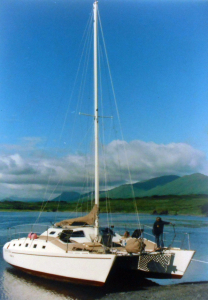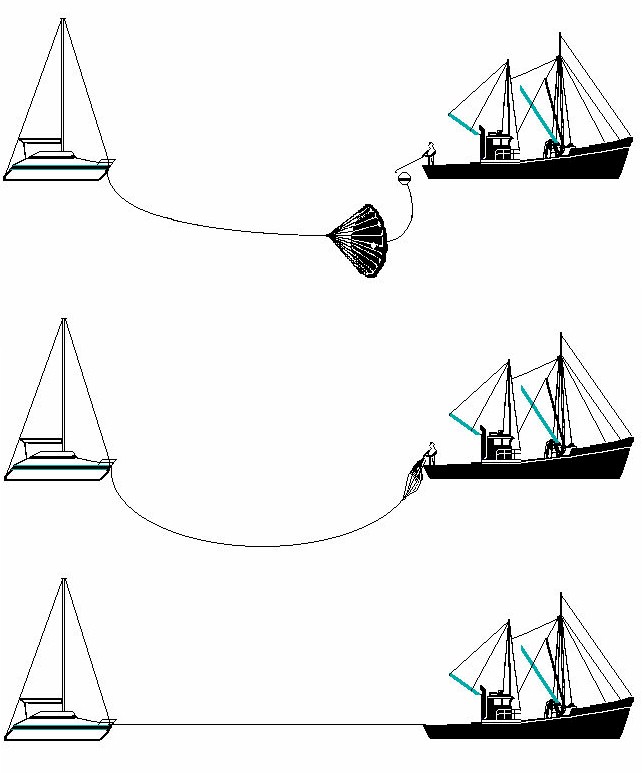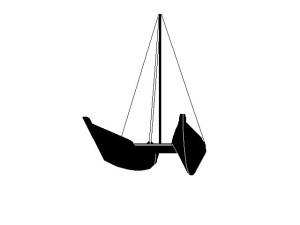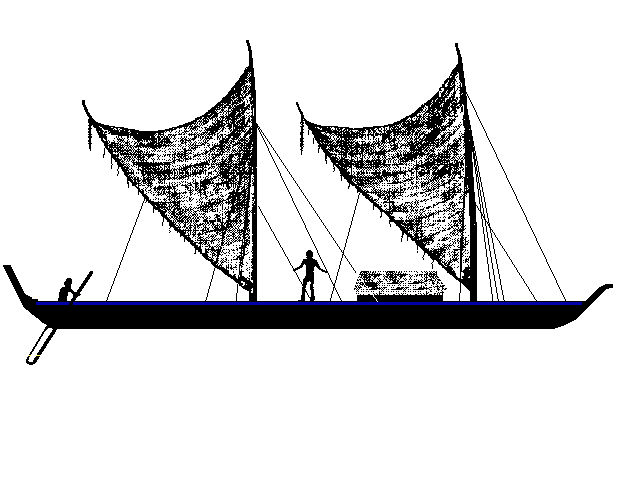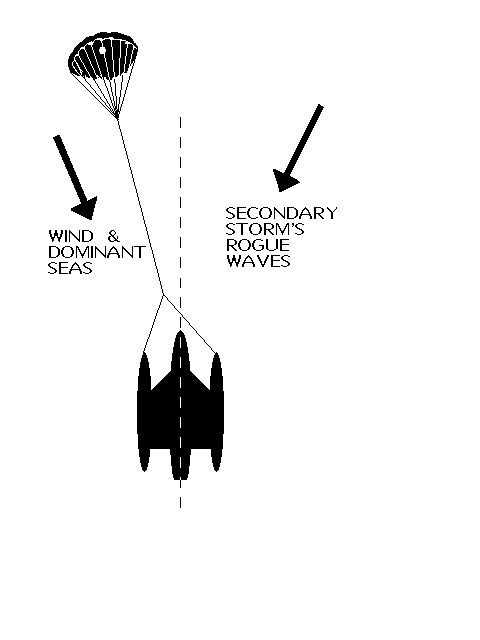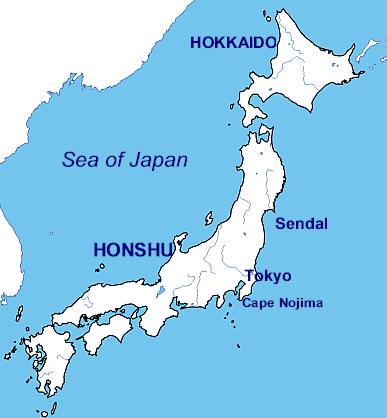S/C-11
Catamaran, Stiletto
29' x 16' x 1.4 Tons
12-Ft. Dia. Sea Anchor
Force 8 Conditions
File S/C-11, obtained from Thomas E. Cooke, Euclid, OH. - Vessel name Battle Cat, hailing port Sandusky, OH, catamaran, designed by Stiletto Catamarans, LOA 29' 4" x Beam 16' x Draft 48" (12" boards up) x 1.4 Tons - Sea anchor: 12-ft. Diameter Para-Tech on 300' x 1/2" nylon braid tether and bridle arms of 50' each, with 1/2" stainless steel swivel - Partial trip line - Deployed in a low system in shallow water (45 feet) on Lake Erie, about 30 miles NW of Cleveland with winds of 40 knots and choppy seas of 8-10 ft. - Vessel's bow yawed 10° - Drift was estimated to be about 300' per hour during 10 hours at sea anchor.
Another difficult situation involving a lightweight multihull, shallow water, low visibility (night), uncertain position, crew fatigue, impaired judgment, vicious squalls and nasty seas, all brought under control by the use of a parachute sea anchor. Transcript:
I have sailed Lake Erie now for four years with the sea anchor on my boat. This is the first time I had a real life-threatening situation where options were limited, and thank God the sea anchor was one of them. To make a long story short, we tried to beat a low pressure system moving in from the southwest, and couldn't. In our haste to outrun this system I made some bad navigation calls, and we ended up following a freighter for about an hour and a half out into Lake Erie's open water, mistaking its lights for the lights of Cedar Point Amusement Park at Sandusky Bay. By the time we figured out we were following a freighter, weather conditions began to deteriorate.
It was 3:00 a.m. when we saw lightning in the west. Diminishing visibility along with increased wind and waves quickly followed. Within 15 minutes we went from 10 knots of wind, 1-2' waves, a starry sky and some lights visible on shore, to 20-25 knots of wind, 5-6' waves, a black sky, literally no horizon and thunder on the increase. The only means of navigation on board were two Horizon compasses. We had no auto-pilot and had been up for 20 hours. We were extremely fatigued and totally disoriented. With no horizon and our brains not functioning too well, (extreme fatigue does funny things to the mind) we decided to deploy the sea anchor and wait until daylight before doing anything else. We deployed the sea anchor in text book fashion. We have the DSB (deployable storage bag). Nothing fouled up, it was almost too easy. The boat slowly drifted downwind and when the rode ran out she swung straight into the wind. At that point we just rode the waves. We lashed sails down and made sure everything was secured and that was all there was to it. On board with me was my sailing buddy, Tom, and my two sons Michael & Bruce. Mike is 9 yrs. old, Bruce is 12 yrs. old and Tom is 37 yrs. old. We contacted the Coast Guard to let them know approx. where we were & what we were doing. At this time the wind was blowing a steady 28 knots & seas were building. It was hard to see how big the waves were with just a flashlight, but the white caps were all over & easy to see.
Tom & I went down below to get some sleep while my son Bruce sat in the cockpit and kept an eye out for freighter lights. By daybreak the wind was blowing steadily in the upper 30's and low 40's, occasionally hitting 48 & 50 knots. The waves were averaging 8' with 3 sets of 10'+ waves every 13th wave. The high wind & waves lasted about six hours & eventually died down to 20-25 knots and 5-6' waves. While we were on sea anchor, listening to channel 16, the Cleveland, Detroit and Fairport Coast Guards were looking for two fishing boats reported overdue the previous night. Both were power boats, one with two adults the other an 18' Bayliner with two adults and three children on board. I can't tell you the compassion we had for them knowing what they had to be dealing with, and at the same time the security we felt while at sea anchor. By the way, both boats and all aboard were found safe the following day, having been blown across the lake to Canada.
Eventually when the wind & waves died down we just powered up to the chute trip line, pulled it, the chute collapsed, we pulled it on board and the rest is history.
A few observations:
1) I never ever thought I would be caught out on Lake Erie in those conditions and survive to tell about it.
2) The sea anchor worked better than I had ever imagined. The boat rode the waves beautifully, up and down, never burying a bow. Came close, but never happened.
3) We would get sea sick only if we went down below and kept our eyes open. If we went down to sleep we were OK. We spent most of our time in the cockpit looking at the waves and how well the sea anchor worked.
4) The boat yawed very little, almost unnoticeably. We tracked drift by movement past commercial fishing nets.
5) The security we felt while being at anchor under those conditions was unbelievable. I would never have thought it possible.
6) After this experience, it is my opinion that no boat should venture offshore without the safety and security of a good sea anchor, tailored for specific boats. At the time, the sea anchor was more important to us than any other piece of safety equipment we had, including the VHF and EPIRB.
Love the Drag Device Database? Help us to keep it free for all mariners by making a tiny donation to cover our server and maintenance costs. Thank You!
